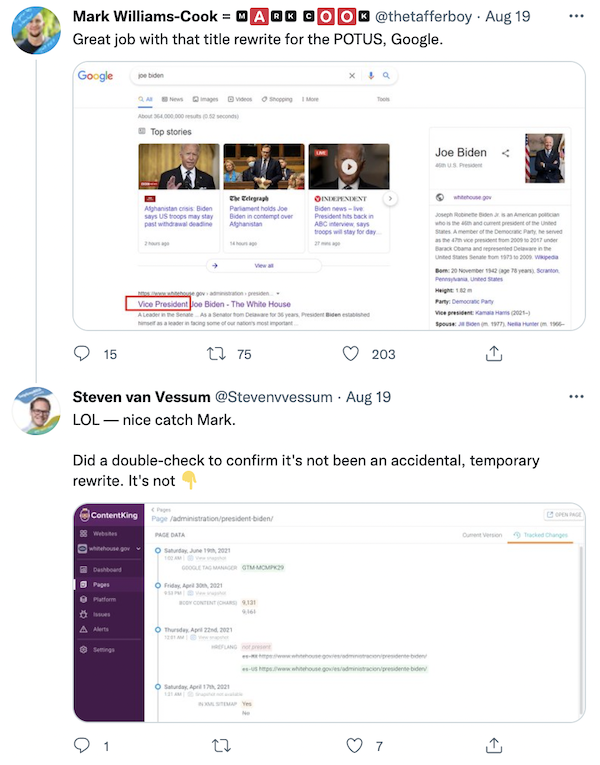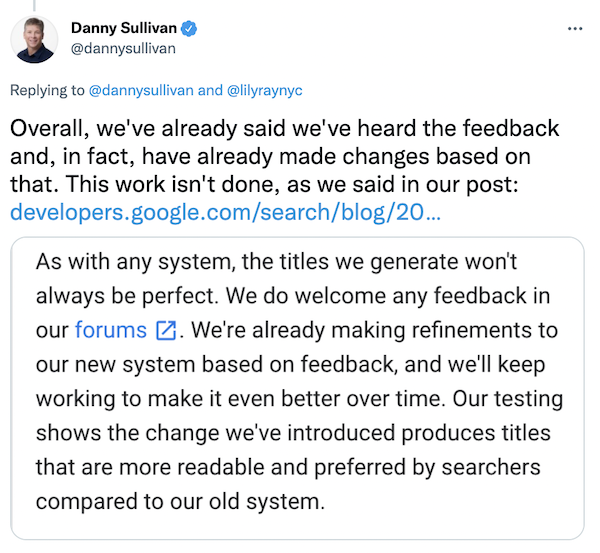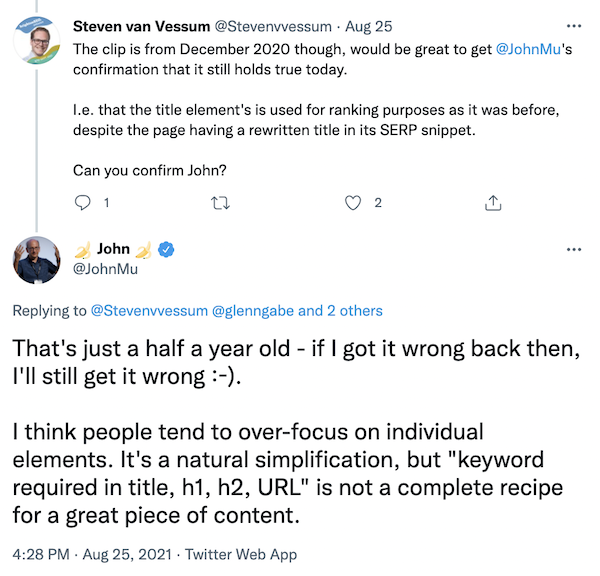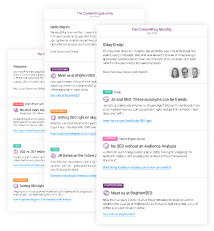Google has updated how web page titles are generated and shown in search results.
Among the SEO community there was speculation (opens in a new tab) that a change had occurred, with the Google Search team acknowledging (opens in a new tab) a handful of comments and points of feedback on social media.
The update was officially confirmed by Google on August 24 in a post (opens in a new tab) explaining the update in more detail.
We double confirmed the update — taking an example shared on Twitter (see below) we used ContentKing Monitoring to see if there were any changes or updates to suggest if the title rewrite was done intentionally. Seeing that there was not, we could confirm that the title change was from the update.
We’ll cover everything we’ve gathered on the title update, what you can expect and what you need to do next.
…was it someone on the team? With ContentKing, you'll know immediately because you are alerted about title changes right away!
What is the title update
Before we dive in, it’s important to note that title changes by Google are not new and has been happening since 2014 (opens in a new tab).
Previously, different titles were triggered by search query, then Google pulled information using various page elements like headings (opens in a new tab), anchor text, and inbound links to generate what is shown in search results. So although this isn’t necessarily new, it does appear that title changes are now more widespread and visible than before.
Now moving to what happened last week — the title update introduced a new system to generate titles for pages.
Before titles were related to search queries, this is no longer the case. Google’s new system will focus primarily on the main visual title or headline of the page.
The page elements considered are primarily text including:
- H1 headings
- Image alt text
- Image file names
- Anchor text for incoming links (either internal or external)
In short, Google will take the content of a page and generate a title they think describes it best.
What to expect from the update
Google’s reasoning behind the update was to improve the search experience — specifically citing (opens in a new tab) long title tags and keyword stuffing.
However in the attempt to generate titles that better describe a page, there have been some examples of less than desirable results occurring such as the example above of President Joe Biden being referred to as Vice President.
The Google Search team has been responsive to the feedback, and have more or less said they will continue (opens in a new tab) to work on it.
From the initial analysis, which keep in mind is still early, there’s been a few things we’ve been seeing:
- Shorter titles: first is the preference for shorter titles, and if titles are too long they will be abbreviated. Brodie Clark’s post (opens in a new tab) describes how the average title length went down.
-
Added branding: next is the emphasis on branding, with brand names being added to titles. For example adding
— ContentKingat the end of a page title.
For those wanting to dive further into the commentary and analysis, check out the following:
Monitor and track your title tags with ContentKing for improved visibility and more clicks to your site.
What you need to know right now
We’ll continue to learn more about the update and its impact in the coming week, but in the meantime here’s what you need to know.
Rankings
Everything we’ve seen so far suggests that this update doesn’t impact rankings. A page’s < title > will still be used for ranking like it was before.
Brand recognition
As we mentioned above, it looks like there will be more emphasis on branding. Brand recognition will become more important, and is something to keep in mind moving forward.
Quality content
Focus on creating quality content for all page elements — including page titles (opens in a new tab) and headlines.
Meaning if you want to increase your chances of Google using your page title, put more effort into writing good page titles. Additionally, writing good headings and structuring them well has become even more important now.
Click-through-rate
While the rewritten titles may not have an impact on rankings, it is very possible that it could on click-through-rates (CTR). There’s been some chatter about this on Twitter and other sites, including an analysis from Wordstream which you can read about here (opens in a new tab).
To keep an eye on this, use Google Search Console to monitor and see if the update has any impact on your site. Zoom in on a relative timeframe to compare, like the week prior to the update compared to the current week, to better visualize how the update is impacting your click-through-rate traffic, if at all.
Should I start changing titles?
A key question surrounding the update: should I start changing titles?
From what we are seeing now, we would suggest not changing titles if you are not seeing any negative impact. If you do see an impact, start tweaking.
What’s next
More likely than not, we’re just seeing the beginning of how this update will impact search results and traffic.
Google’s Danny Sullivan said (opens in a new tab) they are still processing feedback and improving systems. And we’re also seeing continued analysis and commentary from the SEO community on what they’ve been experiencing.
Additionally, there’s a forum thread where you can leave feedback here (opens in a new tab).
Keep in touch with ContentKing for the latest updates. Sign up for our newsletter and follow us on social media:





